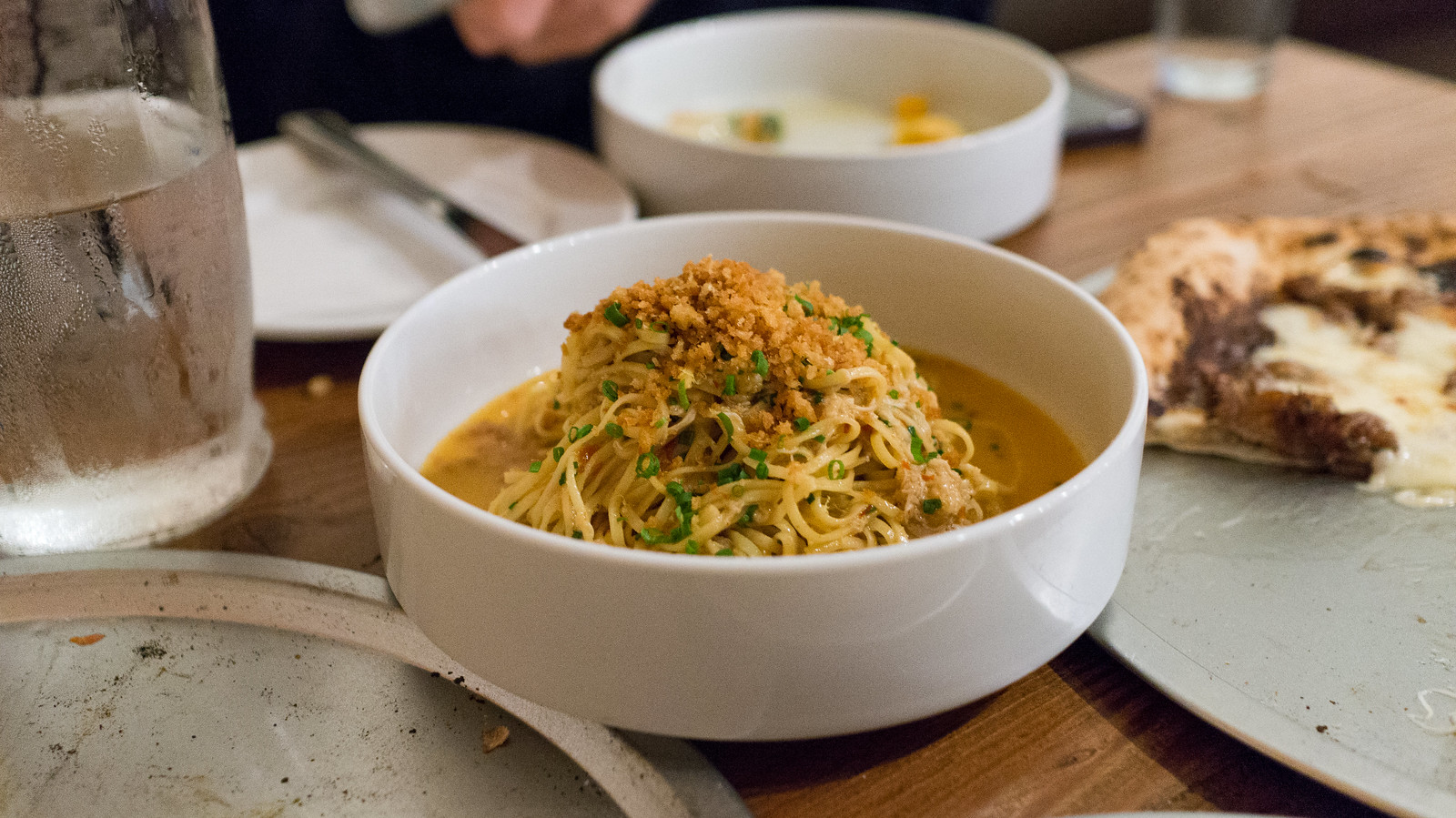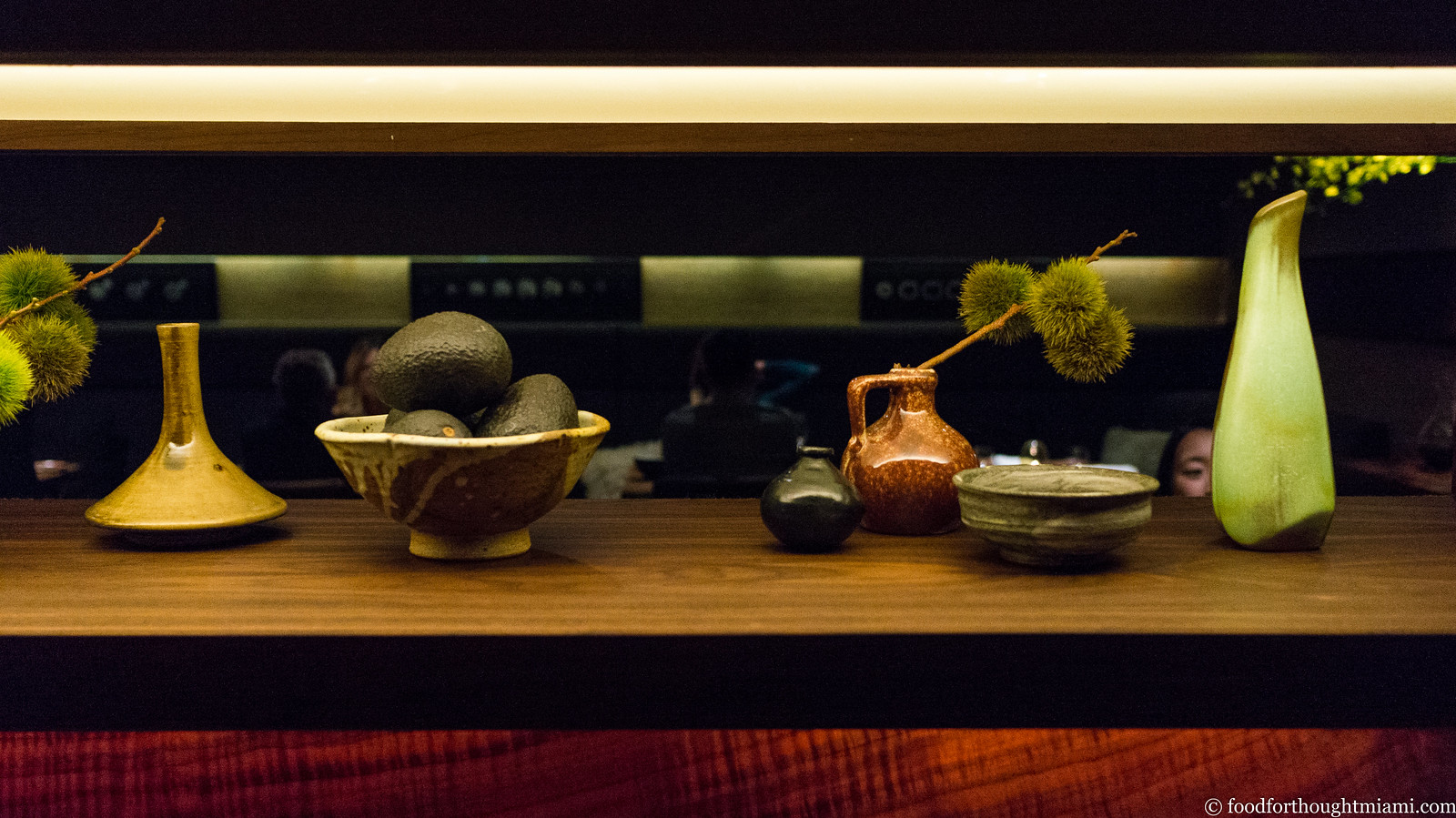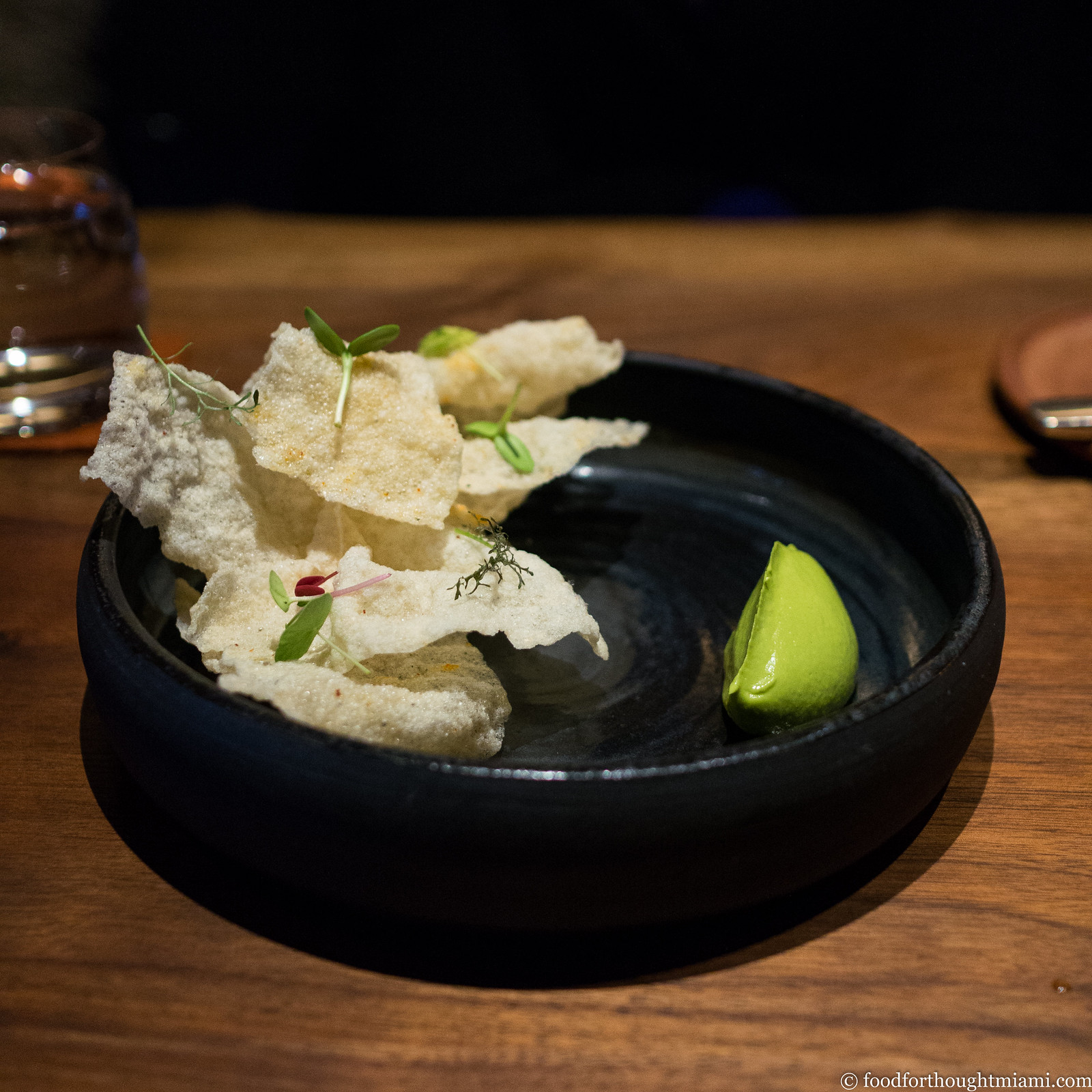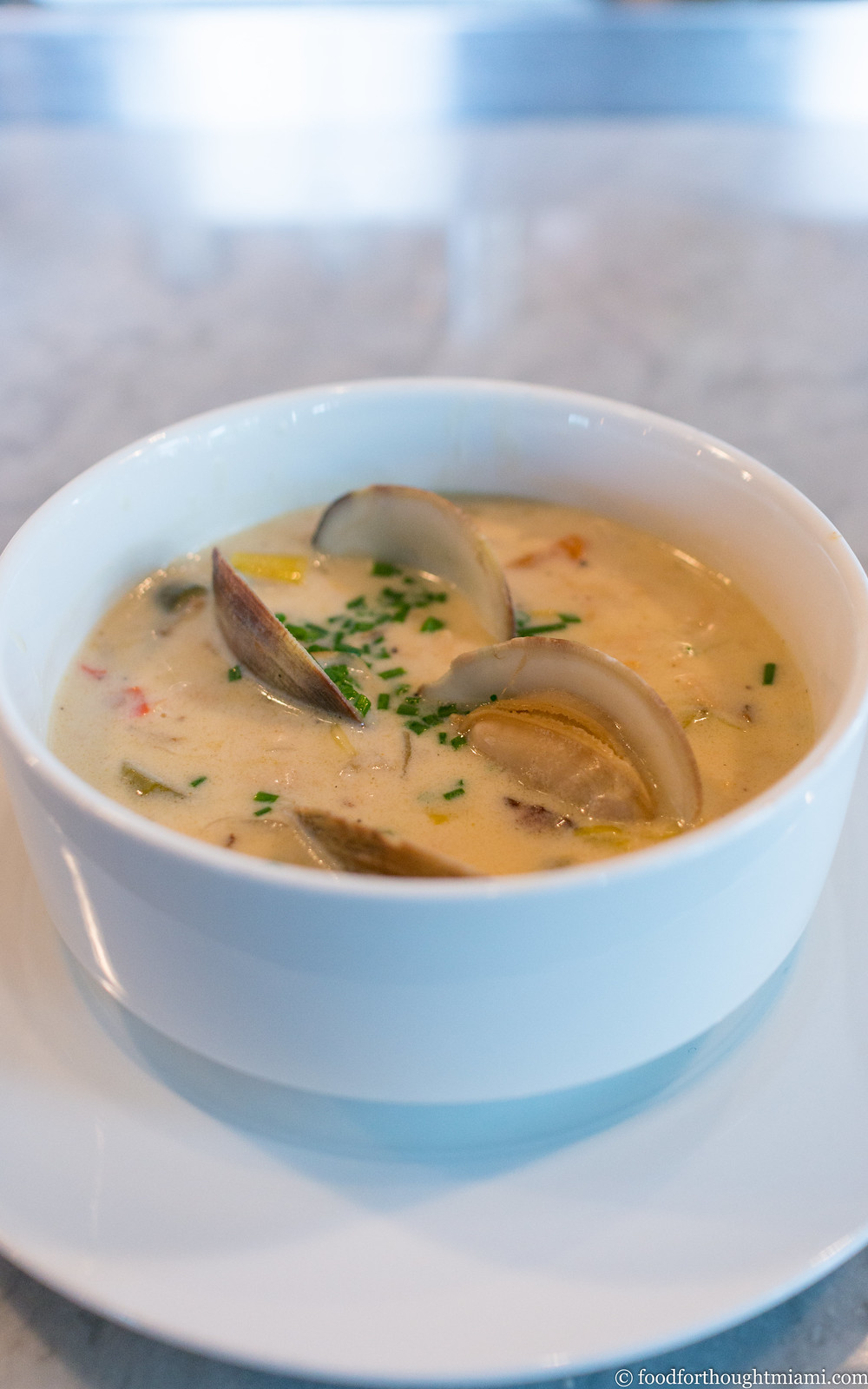Wednesday, September 9, 2015
best thing i ate last week: angel hair with crab, calabrian chili and lemon breadcrumbs at Proof
I don't often go to Italian restaurants, for reasons I've previously expressed. Put in less vulgar terms: it's not so easy to find it done much better than I can do it at home. So when I do go out for Italian, I go to a place like Proof Pizza & Pasta. The modest name belies the seriousness of the cooking here. The pizzas are very good, but the pastas are easily some of the best in town, rivaled only by Macchialina and perhaps Scarpetta (where I haven't been since Nina Compton left).
Case in point: their angel hair with crab. Angel hair is usually the most insipid and pointless of pastas, but here the noodles still have a substantial texture despite their diminutive width, making them an ideal vehicle for the sweet crabmeat. It all swims in an intense crustacean sauce somewhere between broth and bisque, with some Calabrian chiles for some zing, and lemon breadcrumbs for brightness and texture. It was the best thing I ate last week.
All the pastas at Proof are pretty consistently excellent, but I'd also suggest you not sleep on the bucatini with uni and roasted cauliflower, which was a new addition to the menu on my last visit.
(That picture is from about a year ago, though the dish remains the same; you can see all my pictures in this Proof Pizza & Pasta - Miami flickr set).
Runners up: this excellent house-made charcuterie board at Edge Steak and Bar in Brickell; this cured and oil-poached local tuna and kimchi reuben from Josh's Deli.
Tuesday, September 8, 2015
Coi - San Francisco
There's a passage in Daniel Patterson's book "Coi: Stories and Recipes" that I found almost painfully evocative. The chef was writing about his first restaurant in Sonoma, and the turning of the season from summer to fall:
It was when the rains came, and the tourists went away. The first year the bills piled up on the mantelpiece at home, one pile per week, carefully bound with a rubber band, the total owed marked on a Post-it on top. At first there were two, then four and later eight piles, sitting there as a constant reminder of our empty dining room. The rain cut off roads and flooded fields, seeping into our subterranean bedroom at home, filling it with the smell of damp concrete and mold. Subsequent years were never as bad as the first, but every fall after that, as the days shortened and our bank account dwindled, my heart broke a little as we dug in for an isolated, depressing winter. That was some time ago, but the scars still remain. Every year, even now, when I step outside and feel that the light has changed, that it is fall and that summer is gone, I fight down a rising panic. It will be all right, I tell myself, over and over, until eventually I believe it enough to keep going.Coi is one of the more unusual "cookbooks" I've read lately. It's not so much the format, which pairs a thoughtful one-page essay with each recipe, nor even the initially somewhat distracting decision to put all the ingredients and quantities for those recipes in a separate index at the back of the book. And while Patterson can wax seriously eloquent about what inspires his dishes and how to cook them, it wasn't entirely that either. What was so striking was his willingness to provide these personal and often brutally candid insights into the fears and frustrations of being a professional chef.
The restaurant business is a weird and particularly tough one that seems to be constantly teetering between success and failure, both on a macro and micro level. In a sea of competition, it's hard enough to figure out what's going to capture the dining audience's interest. Then you actually have to make it work. Even when you do, this year's hot-spot can quickly turn into next year's has-been. Get all the big things right, and you're still only as good as your last plate: some line cook screws up the seasoning or cooking time on one dish, or your server is having a lousy day, and a customer leaves with a bad impression that you may never have a second chance to remedy.
From reading his book and following his career, it's clear Patterson recognizes and, in his own way, embraces this dance on the edge. In the essay about his "beet rose," an almost absurdly labor-intensive dish in which slivers of roasted beet are assembled by hand to resemble the petals of a rose, then paired with an aerated yogurt and rose petal granita, he describes it like this:
When a dish is right, there is synchronicity between form and substance, idea and execution. This is a dish that was meant to be challenging to make, impractical to reproduce. There is something about its unreasonableness which makes it more impactful. For it to work, everything has to be perfect. ... But I came to love it most for what it represented to me: intuitive, handmade cooking. Each rose is a little different, and I can pick out who made which one every night. The seasoning is finely tuned, wobbling on the edge of sweet and savory, always close to tumbling into failure.That sounds a little crazy, but yeah, I'd like to experience that. Because as good a writer as he is, Patterson is pretty universally recognized to be an even better chef. And yet I'd never paid a visit to the restaurant from which the book takes its name. My travels to the West Coast are almost always with family, which means my opportunities to do tasting menus are limited. And other, shinier objects always seemed to beckon. Then a month ago, Patterson announced that he was stepping down as executive chef at Coi and handing over the reigns to chef Matthew Kirkley in January. It was a surprising announcement: first, because Patterson's work at Coi has been so highly regarded, but even more so because it has been so definitively Patterson's restaurant, and his style of cooking is so personal, that the two seemed inseparable.[1]
We already had a trip to San Francisco coming up. So this would likely be the last chance, for the foreseeable future anyway, to catch Patterson in the kitchen. I re-jiggered the agenda, talked the family into doing a tasting menu dinner,[2] and booked a reservation at Coi. When they asked me what kind of restaurant it is, I wasn't sure exactly how to answer. What I knew is that it's a tasting menu format (but much more restrained than the 20+ course bacchanals like Saison); that it's got some locavore / forager sensibilities, but is not wedded to them; and that the cooking uses, but does not seem defined by, contemporary techniques and processes. This undefinability is also something of which Patterson is acutely self-aware:
When it comes to what a marketing wonk would call 'brand clarity,' we don't do ourselves any favors. ... When someone asks, 'What's the food like?' the best thing I can come up with is, 'Um, hopefully delicious,' my voice rising at the end in a note of uncertainty.Well, let's see.
For this farewell tour of sorts, Patterson has seeded the menu with several "greatest hits," and his "California Bowl" is one of those. It's really just an elevated version of chips and dip using some of the basic tropes of California hippie cuisine: brown rice, avocado and sprouts. But those chips (made from rice cooked down to a paste, dehydrated, then fried like chicharrones) are light and airy and have a tingle of spice, the avocado is whipped until soft as a cloud, and zinging with lime, the tiny greens have bright, fresh, intense flavors.
(You can see all my pictures from the dinner in this Coi - San Francisco flickr set).
(continued ...)
Monday, August 31, 2015
best thing i ate last week: new england clam chowder at Mignonette
I'm still working on getting caught up from our vacation, but in the interest of not falling too far behind, let's talk about this past week. Actually, it mostly consisted of lots of home cooking, which is not a bad thing; but not as good as this New England clam chowder, Sunday's "CBGB" (Chowder, Bisque or GumBo) at Mignonette.
First things first. It's the right kind of clam chowder: New England style, lashed with cream, not that perverse red abomination that some tasteless troglodytes prefer. James Beard had it right, describing "that rather horrendous soup called Manhattan clam chowder" as resembling "a vegetable soup that accidentally had some clams dumped into it."
But even better: it's not so dense with cream that you can't taste anything else. The creamy broth is cut with vinegar and cayenne (I always dash my chowder with hot sauce, but Mignonette chef Bobby Frank saves me the trouble), brightening and lightening it so you can taste the clams, bacon and potatoes bobbing within. A couple plump steamed middlenecks are floated on top just before it's served.
It was the highlight of a Sunday brunch that also included some nice briny oysters, a crudo of cobia tweaked with tart huckleberry juice and diced jalapeño, and a hearty eggs benedict with shrimp and sherry cayenne aioli.
(You can see all my pictures from brunch – and more – in this Mignonette - Miami (Edgewater) flickr set).
First things first. It's the right kind of clam chowder: New England style, lashed with cream, not that perverse red abomination that some tasteless troglodytes prefer. James Beard had it right, describing "that rather horrendous soup called Manhattan clam chowder" as resembling "a vegetable soup that accidentally had some clams dumped into it."
But even better: it's not so dense with cream that you can't taste anything else. The creamy broth is cut with vinegar and cayenne (I always dash my chowder with hot sauce, but Mignonette chef Bobby Frank saves me the trouble), brightening and lightening it so you can taste the clams, bacon and potatoes bobbing within. A couple plump steamed middlenecks are floated on top just before it's served.
It was the highlight of a Sunday brunch that also included some nice briny oysters, a crudo of cobia tweaked with tart huckleberry juice and diced jalapeño, and a hearty eggs benedict with shrimp and sherry cayenne aioli.
(You can see all my pictures from brunch – and more – in this Mignonette - Miami (Edgewater) flickr set).
Subscribe to:
Posts (Atom)




